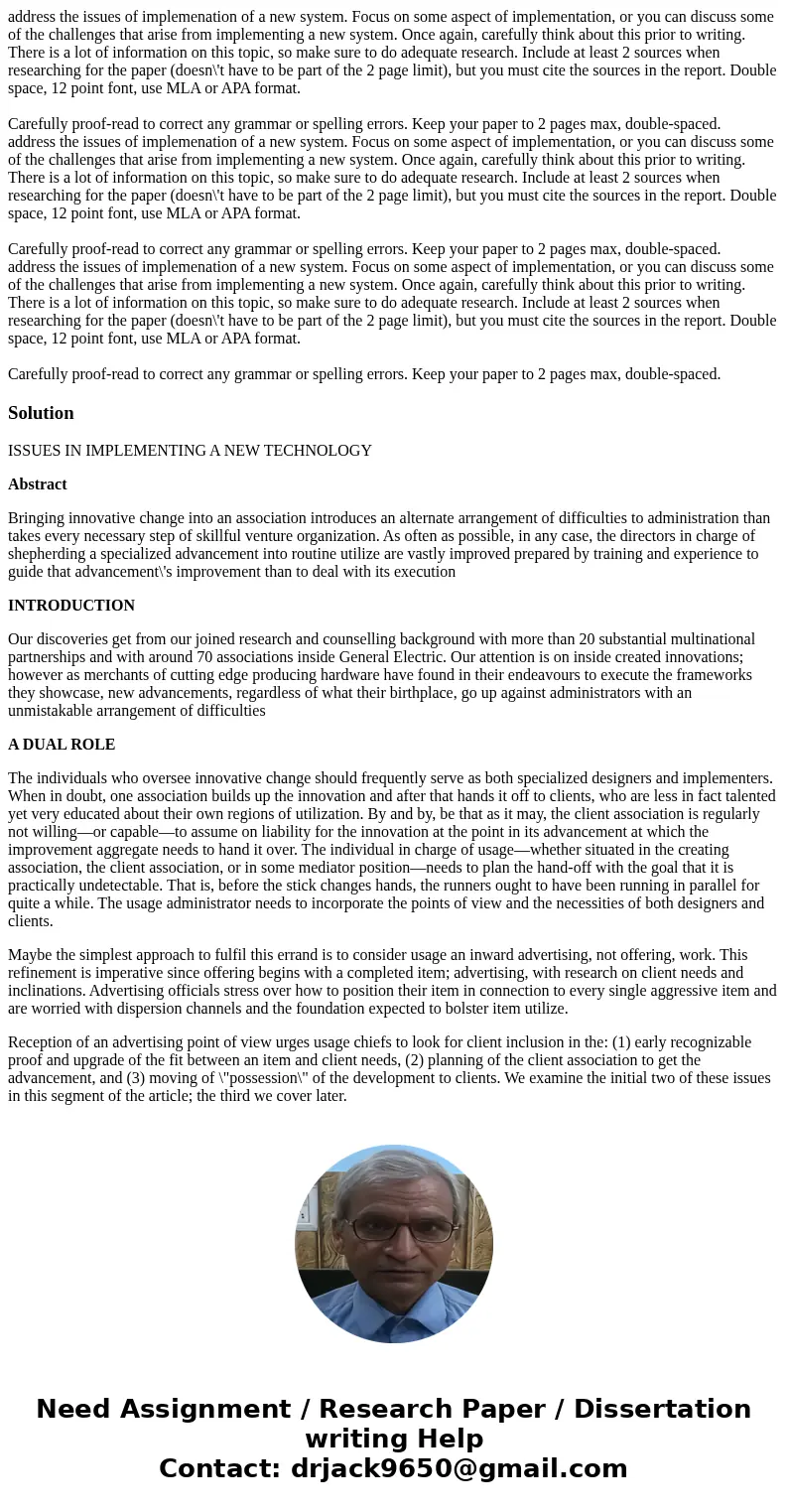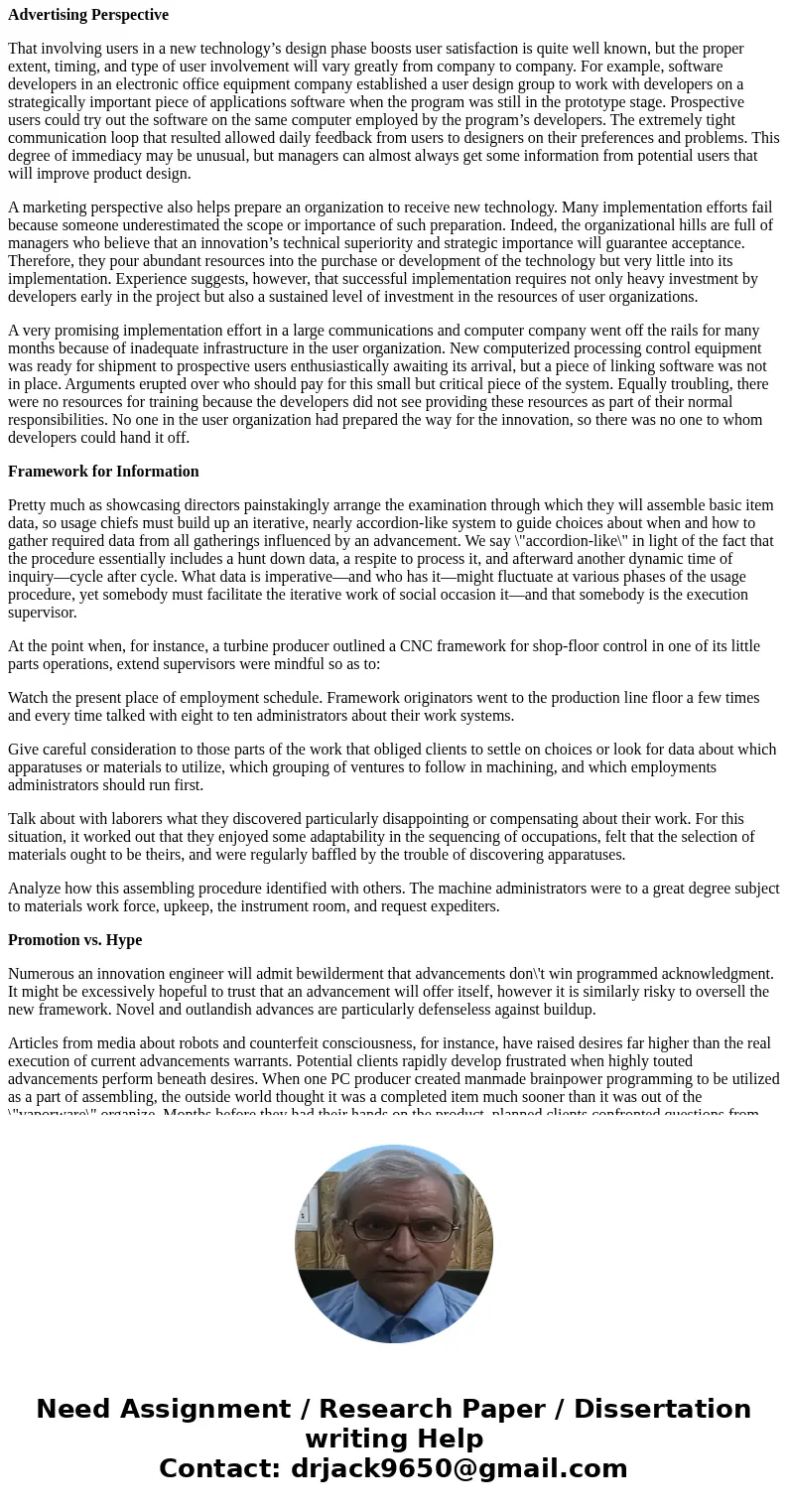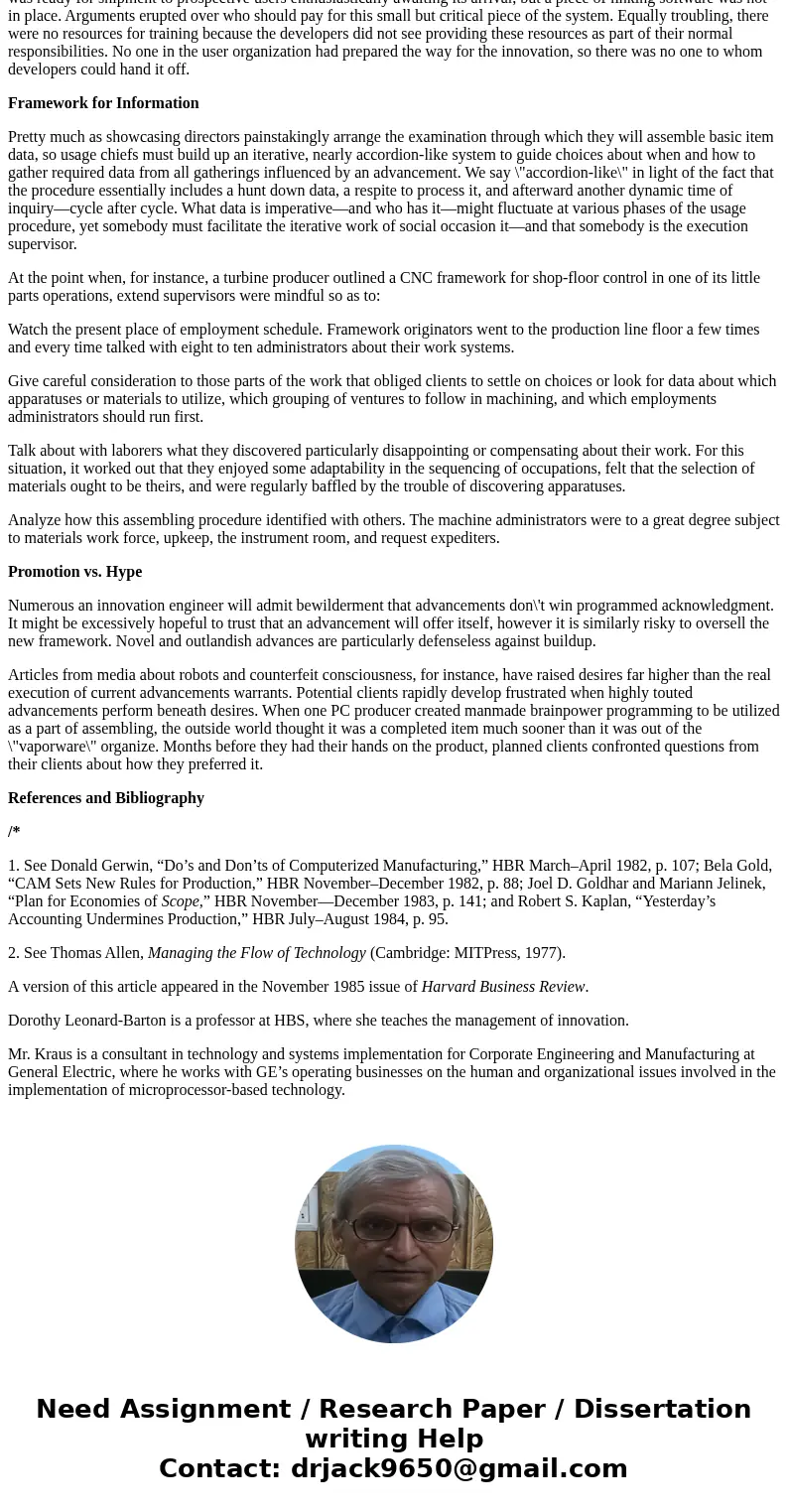address the issues of implemenation of a new system Focus on
Solution
ISSUES IN IMPLEMENTING A NEW TECHNOLOGY
Abstract
Bringing innovative change into an association introduces an alternate arrangement of difficulties to administration than takes every necessary step of skillful venture organization. As often as possible, in any case, the directors in charge of shepherding a specialized advancement into routine utilize are vastly improved prepared by training and experience to guide that advancement\'s improvement than to deal with its execution
INTRODUCTION
Our discoveries get from our joined research and counselling background with more than 20 substantial multinational partnerships and with around 70 associations inside General Electric. Our attention is on inside created innovations; however as merchants of cutting edge producing hardware have found in their endeavours to execute the frameworks they showcase, new advancements, regardless of what their birthplace, go up against administrators with an unmistakable arrangement of difficulties
A DUAL ROLE
The individuals who oversee innovative change should frequently serve as both specialized designers and implementers. When in doubt, one association builds up the innovation and after that hands it off to clients, who are less in fact talented yet very educated about their own regions of utilization. By and by, be that as it may, the client association is regularly not willing—or capable—to assume on liability for the innovation at the point in its advancement at which the improvement aggregate needs to hand it over. The individual in charge of usage—whether situated in the creating association, the client association, or in some mediator position—needs to plan the hand-off with the goal that it is practically undetectable. That is, before the stick changes hands, the runners ought to have been running in parallel for quite a while. The usage administrator needs to incorporate the points of view and the necessities of both designers and clients.
Maybe the simplest approach to fulfil this errand is to consider usage an inward advertising, not offering, work. This refinement is imperative since offering begins with a completed item; advertising, with research on client needs and inclinations. Advertising officials stress over how to position their item in connection to every single aggressive item and are worried with dispersion channels and the foundation expected to bolster item utilize.
Reception of an advertising point of view urges usage chiefs to look for client inclusion in the: (1) early recognizable proof and upgrade of the fit between an item and client needs, (2) planning of the client association to get the advancement, and (3) moving of \"possession\" of the development to clients. We examine the initial two of these issues in this segment of the article; the third we cover later.
Advertising Perspective
That involving users in a new technology’s design phase boosts user satisfaction is quite well known, but the proper extent, timing, and type of user involvement will vary greatly from company to company. For example, software developers in an electronic office equipment company established a user design group to work with developers on a strategically important piece of applications software when the program was still in the prototype stage. Prospective users could try out the software on the same computer employed by the program’s developers. The extremely tight communication loop that resulted allowed daily feedback from users to designers on their preferences and problems. This degree of immediacy may be unusual, but managers can almost always get some information from potential users that will improve product design.
A marketing perspective also helps prepare an organization to receive new technology. Many implementation efforts fail because someone underestimated the scope or importance of such preparation. Indeed, the organizational hills are full of managers who believe that an innovation’s technical superiority and strategic importance will guarantee acceptance. Therefore, they pour abundant resources into the purchase or development of the technology but very little into its implementation. Experience suggests, however, that successful implementation requires not only heavy investment by developers early in the project but also a sustained level of investment in the resources of user organizations.
A very promising implementation effort in a large communications and computer company went off the rails for many months because of inadequate infrastructure in the user organization. New computerized processing control equipment was ready for shipment to prospective users enthusiastically awaiting its arrival, but a piece of linking software was not in place. Arguments erupted over who should pay for this small but critical piece of the system. Equally troubling, there were no resources for training because the developers did not see providing these resources as part of their normal responsibilities. No one in the user organization had prepared the way for the innovation, so there was no one to whom developers could hand it off.
Framework for Information
Pretty much as showcasing directors painstakingly arrange the examination through which they will assemble basic item data, so usage chiefs must build up an iterative, nearly accordion-like system to guide choices about when and how to gather required data from all gatherings influenced by an advancement. We say \"accordion-like\" in light of the fact that the procedure essentially includes a hunt down data, a respite to process it, and afterward another dynamic time of inquiry—cycle after cycle. What data is imperative—and who has it—might fluctuate at various phases of the usage procedure, yet somebody must facilitate the iterative work of social occasion it—and that somebody is the execution supervisor.
At the point when, for instance, a turbine producer outlined a CNC framework for shop-floor control in one of its little parts operations, extend supervisors were mindful so as to:
Watch the present place of employment schedule. Framework originators went to the production line floor a few times and every time talked with eight to ten administrators about their work systems.
Give careful consideration to those parts of the work that obliged clients to settle on choices or look for data about which apparatuses or materials to utilize, which grouping of ventures to follow in machining, and which employments administrators should run first.
Talk about with laborers what they discovered particularly disappointing or compensating about their work. For this situation, it worked out that they enjoyed some adaptability in the sequencing of occupations, felt that the selection of materials ought to be theirs, and were regularly baffled by the trouble of discovering apparatuses.
Analyze how this assembling procedure identified with others. The machine administrators were to a great degree subject to materials work force, upkeep, the instrument room, and request expediters.
Promotion vs. Hype
Numerous an innovation engineer will admit bewilderment that advancements don\'t win programmed acknowledgment. It might be excessively hopeful to trust that an advancement will offer itself, however it is similarly risky to oversell the new framework. Novel and outlandish advances are particularly defenseless against buildup.
Articles from media about robots and counterfeit consciousness, for instance, have raised desires far higher than the real execution of current advancements warrants. Potential clients rapidly develop frustrated when highly touted advancements perform beneath desires. When one PC producer created manmade brainpower programming to be utilized as a part of assembling, the outside world thought it was a completed item much sooner than it was out of the \"vaporware\" organize. Months before they had their hands on the product, planned clients confronted questions from their clients about how they preferred it.
References and Bibliography
/*
1. See Donald Gerwin, “Do’s and Don’ts of Computerized Manufacturing,” HBR March–April 1982, p. 107; Bela Gold, “CAM Sets New Rules for Production,” HBR November–December 1982, p. 88; Joel D. Goldhar and Mariann Jelinek, “Plan for Economies of Scope,” HBR November—December 1983, p. 141; and Robert S. Kaplan, “Yesterday’s Accounting Undermines Production,” HBR July–August 1984, p. 95.
2. See Thomas Allen, Managing the Flow of Technology (Cambridge: MITPress, 1977).
A version of this article appeared in the November 1985 issue of Harvard Business Review.
Dorothy Leonard-Barton is a professor at HBS, where she teaches the management of innovation.
Mr. Kraus is a consultant in technology and systems implementation for Corporate Engineering and Manufacturing at General Electric, where he works with GE’s operating businesses on the human and organizational issues involved in the implementation of microprocessor-based technology.



 Homework Sourse
Homework Sourse